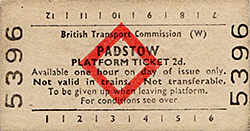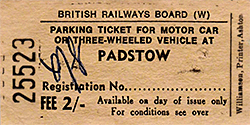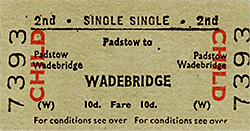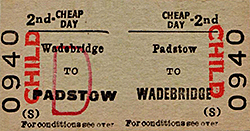|
 |
 |
 |
 |
old63.jpg)
Southern Railway N class 2-6-0 No.1842 approaches Padstow on an unknown date with a service from either Halwill or Exeter Central. The train comprises an unidentified 2-car set of ex-LSWR stock and two vans, the latter probably for fish traffic. The vans would be 'XP rated', as it is now commonly known, meaning they were fitted with the continuous automatic brake to permit operation with passenger trains. New in 1924, No.1842 began life as No.A842 and was one of the 'Woolworths' build from kits supplied by Woolwich Arsenal. She became No.1842 in 1931 and then BR No.31842 in 1949. Much of her life had been spent at either Exmouth Junction or Barnstaple Junction sheds but withdrawal came at Guildford in September 1965, following which she was sent almost immediately to Cashmore's, Newport, for scrapping. The Maunsell N class was based on the GWR 4300 class although the two had visually little in common above the running plates. On the left part of Padstow's turntable pit while the rock wall on the right gives an idea of the terrain and amount of engineering required when building the railway. At this point the railway was effectively on a ledge overlooking the Camel estuary. Indeed the line followed the River Camel all the way to Wadebridge and beyond and on that basis alone it was a great shame when it closed. But in the 1960s such tourism potential was not on the agenda; people instead were looking much further afield to such places as Majorca, irrespective of whether they could pronounce the names properly, or spell them (Mallorca!).
Photo from Malcolm McCarthy collection
old109.jpg)
old59.jpg)
old87.jpg)
Photo from Malcolm McCarthy collection
old109.jpg)
Drummond T9 No.30704 waits at Padstow. This locomotive was withdrawn in October 1951 so the picture will date from the 1948 - 51 period. Dating from 1899, No.30704 was one of the class with narrow splashers. The earlier withdrawals of T9 class members was the reason for the drafting-in of the Maunsell N class 2-6-0s. The young boy, no doubt thinking he would one day be an engine driver, looking at the locomotive creates a scene which could once be seen at almost every railway station. One can only hope No.30704's safety valves did not lift, necessitating a change of underpants. Most children, however, who grew up in the steam age were well used to the characteristics of locomotives and viewed the various sounds with excitement rather than fear. Times change and today there are children who have never travelled by train, let alone seen a steam locomotive in action.
Photo from John Mann collection
old110.jpg)
Photo from John Mann collection
old110.jpg)
On an unknown date in early British Railways days a Drummond T9 is seen legging-it away from Padstow. The locomotive appears to be No.30713 but this is highly unlikely. More likely is No.30712. To explain, No.713 was one of several class members set aside in 1948 for conversion to oil burning. The work was never carried out and the locomotives withdrawn instead during 1951. No.713 is believed to have never received its BR number and given that it was set aside in 1948 this is highly probable. As for No.30712, she was sent to Exmouth Junction in 1951 and remained at that shed until withdrawn in November 1958. The train is in BR carmine and cream livery. This livery suited the older pre-nationalisation stock but less so the Bulleid stock and BR MkI stock on which it had a rather 'amateur' appearance. The set number is difficult to see but under magnification appears to be set No.24 which comprised brake third S2382S and brake composite S6602S. It survived until July 1964 and was one of the so-called 'P sets' intended for the North Cornwall lines. Set 24 was one of the very few P sets not to have its vehicles replaced whilst retaining the set number. On the right is the turntable and water tower. Visible beside the rudimentary shelter on the turntable is the pipe for connecting to a locomotive vacuum supply. The slot in the brick base of the water tower is curious. Was it used as a Home Guard rifleman's position during WWII? Perhaps somebody can enlighten us.
Photo from John Mann collection
Photo from John Mann collection
old59.jpg)
A Class T9 'Greyhound' 4-4-0 has just arrived at Padstow with a train from, according to the headcode disc, Halwill. Magnification of the original image suggests the locomotive is No.30725. This locomotive was based at Exmouth Junction until October 1951 so this would date the photograph to sometime between nationalisation and October 1951. The 'Blood & Custard' liveried coaches on the left would also be right for this period although this livery lingered for many years after BR switched to maroon or, on the Southern Region, green. The train at the platform appears to comprise a 2-car Maunsell set, while three other Maunsell vehicles can be seen stabled in the distance. Of the other passenger stock visible, most is Bulleid designed mainline stock. This stock, as with other pre-nationalisation designs, continued to be built by BR until the standard Mk I stock appeared from 1951 onwards. The general layout of this Bulleid stock was that upon which the BR Mk I was based, although structurally the two types were radically different. The Bulleid stock seen above may have been for the Atlantic Coast Express but it was not uncommon, especially outside the summer season, to see just one or two of these coaches trundling along behind a Bulleid Pacific on local services in the area. Note the general neatness of the station area and the apparently well maintained platform. The plume of steam at centre-right background suggests the presence of another locomotive.
Photo from Malcolm McCarthy collection
Photo from Malcolm McCarthy collection
old87.jpg)
A quiet day at Padstow station in June 1950. The sloping roof at the end of the station building is the gents' toilet and alongside, also with a sloping roof, the porters' room. The stationmaster had a small garden at the front of the building running round in front of the porters' room. The building at the end of the platform is the lamp room.
Photo by JH Aston
old48.jpg)
old49.jpg)
old118.jpg)
old81.jpg)
old99.jpg) Un-rebuilt Bulleid West Country class No. 34036 'Westward Ho' lurks around the turntable at Padstow on an unknown date. She has worked a portion of, or is preparing to work, the Atlantic Coast Express and is about to be turned. No.34036 was one of the type eventually rebuilt into conventional form without the air-smoothed casing. This work took place during the summer of 1959 so the photograph will predate this. The locomotive was based at Exmouth Junction from January 1958, therefore we can date the picture to the 1958-60 period. Following rebuilding she returned to Exmouth Junction where she remained until November 1963. Destined to survive until the end of steam on the Southern Region, she was withdrawn from Nine Elms in July 1967 and scrapped the following year at Cashmore's Newport. The 'Westward Ho' nameplate lacks the exclamation mark with which Westward Ho! is properly spelled. The location is a village near Bideford and known among railway historians for the one-time Bideford, Westward Ho! & Appledore Railway. No.34036 was one of a number of the class which ran around minus a crest below the nameplate. There were a number of variations in nameplate and other regalia sometimes, but not in every case, due to the requirement to carry additional adornments for trains such as the ‘Golden Arrow’. The class also carried a small plate in the form of a stylised banner bearing the class name, in the case of No.34036 'West Country Class'. This plate is just visible below the nameplate and low down near the bottom edge of the casing. The ‘Atlantic Coast Express’ had a complex history and a brief version can be read on the main page as well as on
Un-rebuilt Bulleid West Country class No. 34036 'Westward Ho' lurks around the turntable at Padstow on an unknown date. She has worked a portion of, or is preparing to work, the Atlantic Coast Express and is about to be turned. No.34036 was one of the type eventually rebuilt into conventional form without the air-smoothed casing. This work took place during the summer of 1959 so the photograph will predate this. The locomotive was based at Exmouth Junction from January 1958, therefore we can date the picture to the 1958-60 period. Following rebuilding she returned to Exmouth Junction where she remained until November 1963. Destined to survive until the end of steam on the Southern Region, she was withdrawn from Nine Elms in July 1967 and scrapped the following year at Cashmore's Newport. The 'Westward Ho' nameplate lacks the exclamation mark with which Westward Ho! is properly spelled. The location is a village near Bideford and known among railway historians for the one-time Bideford, Westward Ho! & Appledore Railway. No.34036 was one of a number of the class which ran around minus a crest below the nameplate. There were a number of variations in nameplate and other regalia sometimes, but not in every case, due to the requirement to carry additional adornments for trains such as the ‘Golden Arrow’. The class also carried a small plate in the form of a stylised banner bearing the class name, in the case of No.34036 'West Country Class'. This plate is just visible below the nameplate and low down near the bottom edge of the casing. The ‘Atlantic Coast Express’ had a complex history and a brief version can be read on the main page as well as on
numerous external sites.
Photo from Jim Lake collection
old121.jpg)
Photo by JH Aston
old48.jpg)
A passenger train is pulling out of Padstow probably sometime in the 1950s. The headcode disc on the loco seems a little odd as it is indicating a Bude service but it is likely a second disc obscured from view by the smoke deflector nearest the camera. This would be more likely as it would indicate a Padstow - Exeter Central service. The buildings in the background are part of the Pawlyn Brothers’ fish curing depot located at the north end of the Padstow turntable. No.31843 was one of the N class 2-6-0s which originated with the SE&CR. Intended, obviously, for the routes of the SE&CR a number were moved to Exmouth Junction and Barnstaple Junctions sheds with this example moving west as early as 1951. The N class had a couple of nicknames; 'Mongolipers' and 'Woolworths'. The latter was the best known nickname and came about through 50 of the class (of 80) being built at Ashford from kits of parts manufactured at Woolwich Arsenal. This was a government initiative to retain a skilled workforce at Woolwich towards the end of, and following, WWI. Woolwich did not have the facilities to construct complete locomotives, hence kits of parts, with boilers being subcontracted to firms such as North British. Woolwich produced more kits than was required by the SE&CR and SR; others were used to rebuild tank locomotives while yet more were sent to Ireland. No.31843 dated from 1924 and was withdrawn in May 1964 from Exmouth Junction. The coaching stock appears to be set No.196. If so, this was a 3-car set formed in 1935 and comprising vehicles S3742S - S5644S - S3743S of which the first and last were BSK types (Brake Second Corridor) and S5644S was a CK (Corridor Composite). It is recording as once having worked on the Swanage branch and was withdrawn in 1962, thus this is the latest year in which the photograph could have been taken.
old49.jpg)
Having just left Padstow 31842 is seen crossing Little Petherick Creek bridge heading towards Wadebridge. The land rising up to the left is Dennis Hill. Loco details are the same as for No.31843 (above) except that No.31842 lasted until September 1965, having been transferred from Exmouth Junction to Guildford in July 1964. The coaching stock, above, is one of the Maunsell 3-car mainline sets but its set number is not visible. Note that it's acquired an overhead warning flash. The only time these sets might have gone anywhere near overhead wires would be if they ventured near one of the Southern's goods yards fitted with overhead wires in place of the third rail. BR, however, began to apply these flashes 'across the board' irrespective of where so-fitted locos and stock worked so the sight of them on the Padstow branch was not as absurd as it may seem.
Photo
from Malcolm McCarthy collection
old118.jpg)
Padstow station in British Railways days with, as was often the case, several members of staff milling around. One would hope the number of passengers on the train outnumbered the staff. The photograph is impossible to date accurately but two points stand out, namely the track at the platform has yet to re-laid (it was later re-laid with flat bottom rails) and the coaching stock is in the early BR 'blood and custard' livery, a livery which had several derogatory names but was officially 'carmine and cream'. From these points we can say the period was 1948 to mid 1950s but no later. The locomotive is an unidentified Beattie well tank and is waiting to depart for Bodmin. The train is one of the North Cornwall Maunsell 'P sets', the second vehicle of which displays the rather odd-looking window arrangement which certain Maunsell stock had. The set number cannot be determined. This or similar sets appear in other photographs. On the right a Bulleid coach is stabled; the body profile and gangway connection on these was quite distinctive. On the left, there appears to be a degree of urgency to reach the signal box so perhaps the train's departure is imminent. Also at left we have a reasonably good view of the lamproom with its part wood and part corrugated iron construction. It may have been corrugated iron or asbestos but as the structure was painted it was probably iron.
old115.jpg)
Photo
from John Mann collection
old115.jpg)
This undated view is timeless, notwithstanding the car just visible through the fence. A clue is the flat bottom rail of the platform road which tells us the photograph dates from British Railways days. A tail lamp has been left on the platform at far left. This type was oil (paraffin) lit and tail lamps were attached to the rear of trains. Their main purpose was to indicate 'train complete' to signalmen. Tail lamps are still required today but are either battery powered or built into the bodywork in a similar manner to road vehicle lights. The poster at extreme left advertises, in a manner of speaking, itself or put another way it is advertising space. Directly ahead of the camera, note the ornate bracket supporting the ‘Gentlemen’ sign. The tubs and stones around the base of the running-in board were once typical of many rural and some urban stations. Such may still be seen today at some locations but often done by Community groups who adopt stations. On the right, the stabled stock is of Bulleid design.
Photo from John Mann collection
old81.jpg)
Ex-LSWR Drummond T9 class BR No.30715 on the turntable at Padstow. The turntable is the 65ft example, installed at the same site of the earlier 50ft turntable which it had replaced in 1947. The T9 class had a rather muddled numbering system, as did several other classes, allocated in non-consecutive blocks. Some batches were built at Nine Elms with others by Dubs & Co, Glasgow. No.30715, new in 1899, was among the latter and was numbered 715 when new, retaining this right through to nationalisation. Indeed, the entire class, with one exception, retained its original numbers until nationalisation when 30000 was added to them. The exception was one built by Dubs & Co in 1901 and numbered 773. It was renumbered to 733 by the Southern and went on to become BR No.30733. While being neat looking machines, the appearance of the T9s was increasingly antiquated by the time BR was formed and the untidy smokebox door clamps did not help. More familiar on Midland Railway designs, a number of Southern types also used this arrangement. No.30715 had been withdrawn sometime around 1949/50 and then reinstated during 1950 but it is unclear quite when she received her BR number. Upon reinstatement she was sent to Exmouth Junction where she remained until final withdrawal in July 1961. The class reached extinction in 1963 with just one, BR No.30120, surviving into preservation. Withdrawn from Exmouth Junction in 1961, No.30120 was overhauled the following year and painted in LSWR green livery as No.120 for working special trains. Officially withdrawn, again, in July 1963 she in fact continued to run until October of that year and thus became the final class member in BR service. The possible WW2 Home Guard gun embrasure in the brick wall at the base of the water tower, seen in the 1950 picture, has been enlarged to create a window.
Photo from Malcolm McCarthy collection
Photo from Malcolm McCarthy collection
old99.jpg) Un-rebuilt Bulleid West Country class No. 34036 'Westward Ho' lurks around the turntable at Padstow on an unknown date. She has worked a portion of, or is preparing to work, the Atlantic Coast Express and is about to be turned. No.34036 was one of the type eventually rebuilt into conventional form without the air-smoothed casing. This work took place during the summer of 1959 so the photograph will predate this. The locomotive was based at Exmouth Junction from January 1958, therefore we can date the picture to the 1958-60 period. Following rebuilding she returned to Exmouth Junction where she remained until November 1963. Destined to survive until the end of steam on the Southern Region, she was withdrawn from Nine Elms in July 1967 and scrapped the following year at Cashmore's Newport. The 'Westward Ho' nameplate lacks the exclamation mark with which Westward Ho! is properly spelled. The location is a village near Bideford and known among railway historians for the one-time Bideford, Westward Ho! & Appledore Railway. No.34036 was one of a number of the class which ran around minus a crest below the nameplate. There were a number of variations in nameplate and other regalia sometimes, but not in every case, due to the requirement to carry additional adornments for trains such as the ‘Golden Arrow’. The class also carried a small plate in the form of a stylised banner bearing the class name, in the case of No.34036 'West Country Class'. This plate is just visible below the nameplate and low down near the bottom edge of the casing. The ‘Atlantic Coast Express’ had a complex history and a brief version can be read on the main page as well as on
Un-rebuilt Bulleid West Country class No. 34036 'Westward Ho' lurks around the turntable at Padstow on an unknown date. She has worked a portion of, or is preparing to work, the Atlantic Coast Express and is about to be turned. No.34036 was one of the type eventually rebuilt into conventional form without the air-smoothed casing. This work took place during the summer of 1959 so the photograph will predate this. The locomotive was based at Exmouth Junction from January 1958, therefore we can date the picture to the 1958-60 period. Following rebuilding she returned to Exmouth Junction where she remained until November 1963. Destined to survive until the end of steam on the Southern Region, she was withdrawn from Nine Elms in July 1967 and scrapped the following year at Cashmore's Newport. The 'Westward Ho' nameplate lacks the exclamation mark with which Westward Ho! is properly spelled. The location is a village near Bideford and known among railway historians for the one-time Bideford, Westward Ho! & Appledore Railway. No.34036 was one of a number of the class which ran around minus a crest below the nameplate. There were a number of variations in nameplate and other regalia sometimes, but not in every case, due to the requirement to carry additional adornments for trains such as the ‘Golden Arrow’. The class also carried a small plate in the form of a stylised banner bearing the class name, in the case of No.34036 'West Country Class'. This plate is just visible below the nameplate and low down near the bottom edge of the casing. The ‘Atlantic Coast Express’ had a complex history and a brief version can be read on the main page as well as onnumerous external sites.
Photo from Jim Lake collection
old121.jpg)
The tide is out in this September 1959 view of Drummond T9 No.30715 crossing Little Petherick Creek bridge on its approach to Padstow. The River Camel is on, and curving towards, the left. Note the sandy bed of the river and creek; sand was, and still is, extracted at Padstow and used in agriculture. In 1900 Pastow Fixed Distant signal was quoted as being 1,111 yards from Padstow signal box but in 1965 it was quoted as being at 1,201 yards but as the diagram showing this was drawn after Padstow box closed so from where the 1,201 yards was measured is unclear. However, the difference corresponds to that from the signal box site to the end of the line so it may have been measured from the latter. A certain mystery remains, though, as to its siting through the decades as some older photographs show a signal sited approximately near the presumed gradient post seen in this 1959 view and coexisting with that visible on the embankment in the background. Of the two coexisting signals one had a moving arm and the other apparently fixed.The train will shortly pass the site of what is today Dennis Cove Campsite. Before the railway was built Dennis Cove contained a shipyard but the building of the railway saw an end to this and the location thereafter became a lake. The locomotive is in the second British Railways livery and has the original BTC/BR crest on the tender. In 1950 No.30715 was sent to Exmouth Junction shed from where she continued to enjoy the countryside of Devon and Cornwall until withdrawal in July 1961. She was one of the batch built by Dubs & Co and paired from new with a 6-wheel tender but later, during August 1903 to be exact, given an 8-wheel 'water cart' tender of the type with which she can be seen here. Exmouth Junction was, incidentally, 72A under BR Southern Region having previously been coded EXJ but became 83D in 1963 when the Western Region took over the ex-Southern lines west of Wilton. No.30715 is heading a train from the Halwill and Okehampton direction. The train is probably a Maunsell 'P set' but only the first vehicle is visible.
Photo from Jim Lake collection
Photo from Jim Lake collection
Click here for Padstow Gallery 7:
August 1960 - c1963

|
| Last updated: Wednesday, 07-Mar-2018 14:50:27 CET | © 1998-2016 Disused Stations |

 Home Page
Home Page